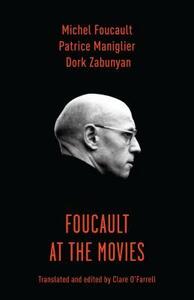Take a photo of a barcode or cover
Foucault at the Movies offers an two essays, by Dork Zabunyan and Patrice Maniglier, that serve as exegeses of the ways in which Foucault's work can be applied to theorizing on cinema, followed by Foucault's own interviews with Cahiers du cinema and discussions with Hélène Cixous, Werner Schroeter, and René Féret.. Zabunyan writes directly about using Foucault as a tool for approaching the moving image, and in particular how Foucault's grappling with history and popular history informs film studies and related areas. Maniglier takes on "Foucault's Metaphysics of the Event Illuminated by Cinema," a mercurial piece of writing that engages with the contradictions between approaches to history. While Zabunyan's essay could be used as an introduction to Foucaultian thought and film, Maniglier's is not for beginners. But I am not sure it is needed for advanced scholars either, as the topics included are ones long discussed in the film studies community and related areas in inquiry. The most valuable part of the book is its reproductions of Foucault's interviews with various directors and other thinkers on memory, popular history, and visual media. While the essays by the authors are valuable, they do not particularly offer new insights, instead spending a lot of space on defending Foucault from having not done more work with film. This is unnecessary: Foucault's writing is such that it can be easily applied to various media and a wide range of genres within media. An annotated volume of the interviews might well have been a better project.
Foucault at the Movies offers an two essays, by Dork Zabunyan and Patrice Maniglier, that serve as exegeses of the ways in which Foucault's work can be applied to theorizing on cinema, followed by Foucault's own interviews with Cahiers du cinema and discussions with Hélène Cixous, Werner Schroeter, and René Féret.. Zabunyan writes directly about using Foucault as a tool for approaching the moving image, and in particular how Foucault's grappling with history and popular history informs film studies and related areas. Maniglier takes on "Foucault's Metaphysics of the Event Illuminated by Cinema," a mercurial piece of writing that engages with the contradictions between approaches to history. While Zabunyan's essay could be used as an introduction to Foucaultian thought and film, Maniglier's is not for beginners. But I am not sure it is needed for advanced scholars either, as the topics included are ones long discussed in the film studies community and related areas in inquiry. The most valuable part of the book is its reproductions of Foucault's interviews with various directors and other thinkers on memory, popular history, and visual media. While the essays by the authors are valuable, they do not particularly offer new insights, instead spending a lot of space on defending Foucault from having not done more work with film. This is unnecessary: Foucault's writing is such that it can be easily applied to various media and a wide range of genres within media. An annotated volume of the interviews might well have been a better project.

